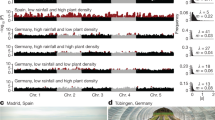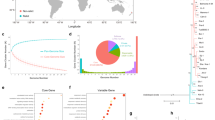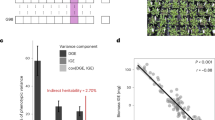Abstract
As Earth is currently experiencing dramatic climate change, it is of critical interest to understand how species will respond to it. The chance of a species withstanding climate change is likely to depend on the diversity within the species and, particularly, whether there are sub-populations that are already adapted to extreme environments. However, most predictive studies ignore that species comprise genetically diverse individuals. We have identified genetic variants in Arabidopsis thaliana that are associated with survival of an extreme drought event—a major consequence of global warming. Subsequently, we determined how these variants are distributed across the native range of the species. Genetic alleles conferring higher drought survival showed signatures of polygenic adaptation and were more frequently found in Mediterranean and Scandinavian regions. Using geo-environmental models, we predicted that Central European, but not Mediterranean, populations might lag behind in adaptation by the end of the twenty-first century. Further analyses showed that a population decline could nevertheless be compensated by natural selection acting efficiently over standing variation or by migration of adapted individuals from populations at the margins of the species’ distribution. These findings highlight the importance of within-species genetic heterogeneity in facilitating an evolutionary response to a changing climate.
This is a preview of subscription content, access via your institution
Access options
Access Nature and 54 other Nature Portfolio journals
Get Nature+, our best-value online-access subscription
$29.99 / 30 days
cancel any time
Subscribe to this journal
Receive 12 digital issues and online access to articles
$119.00 per year
only $9.92 per issue
Buy this article
- Purchase on Springer Link
- Instant access to full article PDF
Prices may be subject to local taxes which are calculated during checkout



Similar content being viewed by others
References
Parmesan, C. & Yohe, G. A globally coherent fingerprint of climate change impacts across natural systems. Nature 421, 37–42 (2003).
Thuiller, W., Lavorel, S., Araújo, M. B., Sykes, M. T. & Prentice, I. C. Climate change threats to plant diversity in Europe. Proc. Natl Acad. Sci. USA 102, 8245–8250 (2005).
Jezkova, T. & Wiens, J. J. Rates of change in climatic niches in plant and animal populations are much slower than projected climate change. Proc. R. Soc. B Biol. Sci. 283, 20162104 (2016).
Barrett, R. D. H. & Schluter, D. Adaptation from standing genetic variation. Trends Ecol. Evol. 23, 38–44 (2008).
Hereford, J. A quantitative survey of local adaptation and fitness trade-offs. Am. Nat. 173, 579–588 (2009).
Turesson, G. The species and the variety as ecological units. Hereditas 3, 100–113 (1922).
Hancock, A. M. et al. Adaptation to climate across the Arabidopsis thaliana genome. Science 334, 83–86 (2011).
Fournier-Level, A. et al. A map of local adaptation in Arabidopsis thaliana. Science 334, 86–89 (2011).
Lasky, J. R. et al. Characterizing genomic variation of Arabidopsis thaliana: the roles of geography and climate. Mol. Ecol. 21, 5512–5529 (2012).
Siepielski, A. M. et al. Precipitation drives global variation in natural selection. Science 355, 959–962 (2017).
Dai, A. Increasing drought under global warming in observations and models. Nat. Clim. Change 3, 52–58 (2012).
Hampe, A. & Petit, R. J. Conserving biodiversity under climate change: the rear edge matters. Ecol. Lett. 8, 461–467 (2005).
Lee-Yaw, J. A. et al. A synthesis of transplant experiments and ecological niche models suggests that range limits are often niche limits. Ecol. Lett. 19, 710–722 (2016).
Berg, J. J. & Coop, G. A population genetic signal of polygenic adaptation. PLoS Genet. 10, e1004412 (2014).
Dormann, C. F. et al. Correlation and process in species distribution models: bridging a dichotomy. J. Biogeogr. 39, 2119–2131 (2012).
1001 Genomes Consortium. 1,135 genomes reveal the global pattern of polymorphism in Arabidopsis thaliana. Cell 166, 481–491 (2016).
Hijmans, R. J., Cameron, S. E., Parra, J. L., Jones, P. G. & Jarvis, A. Very high resolution interpolated climate surfaces for global land areas. Int. J. Climatol. 25, 1965–1978 (2005).
Breiman, L. Random forests. Mach. Learn. 45, 5–32 (2001).
Mojica, J. P. et al. Genetics of water use physiology in locally adapted Arabidopsis thaliana. Plant Sci. 251, 12–22 (2016).
Ingram, J. & Bartels, D. The molecular basis of dehydration tolerance in plants. Annu. Rev. Plant Physiol. Plant Mol. Biol. 47, 377–403 (1996).
Alexander, D. H., Novembre, J. & Lange, K. Fast model-based estimation of ancestry in unrelated individuals. Genome Res. 19, 1655–1664 (2009).
Schiffels, S. & Durbin, R. Inferring human population size and separation history from multiple genome sequences. Nat. Genet. 46, 919–925 (2014).
Lee, C.-R. et al. On the post-glacial spread of human commensal Arabidopsis thaliana. Nat. Commun. 8, 14458 (2017).
Pickrell, J. K. & Pritchard, J. K. Inference of population splits and mixtures from genome-wide allele frequency data. PLoS Genet. 8, e1002967 (2012).
Kang, H. M. et al. Variance component model to account for sample structure in genome-wide association studies. Nat. Genet. 42, 348–354 (2010).
Atwell, S. et al. Genome-wide association study of 107 phenotypes in Arabidopsis thaliana inbred lines. Nature 465, 627–631 (2010).
Gibson, G. Rare and common variants: twenty arguments. Nat. Rev. Genet. 13, 135–145 (2011).
Zhou, X., Carbonetto, P. & Stephens, M. Polygenic modeling with Bayesian sparse linear mixed models. PLoS Genet. 9, e1003264 (2013).
Hedrick, P. W. Genetic polymorphism in heterogeneous environments: the age of genomics. Annu. Rev. Ecol. Evol. Syst. 37, 67–93 (2006).
Pavlidis, P., Živkovic, D., Stamatakis, A. & Alachiotis, N. SweeD: likelihood-based detection of selective sweeps in thousands of genomes. Mol. Biol. Evol. 30, 2224–2234 (2013).
Pritchard, J. K., Pickrell, J. K. & Coop, G. The genetics of human adaptation: hard sweeps, soft sweeps, and polygenic adaptation. Curr. Biol. 20, R208–R215 (2010).
Josephs, E. B., Stinchcombe, J. R. & Wright, S. I. What can genome-wide association studies tell us about the evolutionary forces maintaining genetic variation for quantitative traits? New Phytol. 214, 21–33 (2017).
Lawson, D. J., Hellenthal, G., Myers, S. & Falush, D. Inference of population structure using dense haplotype data. PLoS Genet. 8, e1002453 (2012).
Shriner, D., Adeyemo, A., Ramos, E., Chen, G. & Rotimi, C. N. Mapping of disease-associated variants in admixed populations. Genome Biol. 12, 223 (2011).
Tardieu, F. Any trait or trait-related allele can confer drought tolerance: just design the right drought scenario. J. Exp. Bot. 63, 25–31 (2012).
Ludlow, M. M. in Structural and Functional Responses to Environmental Stress (eds Kreeb, K. H, Richter, H. & Minckley, T. M.) 269–281 (SPB Academic, The Hague, 1989).
Kenney, A. M., McKay, J. K., Richards, J. H. & Juenger, T. E. Direct and indirect selection on flowering time, water-use efficiency (WUE, δ13C), and WUE plasticity to drought in Arabidopsis thaliana. Ecol. Evol. 4, 4505–4521 (2014).
Bac-Molenaar, J. A., Granier, C., Keurentjes, J. J. B. & Vreugdenhil, D. Genome-wide association mapping of time-dependent growth responses to moderate drought stress in Arabidopsis. Plant Cell Environ. 39, 88–102 (2016).
Vasseur, F., Wang, G., Bresson, J., Schwab, R. & Weigel, D. Image-based methods for phenotyping growth dynamics and fitness in large plant populations. Preprint at https://www.biorxiv.org/content/early/2017/10/25/208512 (2017).
Juenger, T. E. et al. Identification and characterization of QTL underlying whole-plant physiology in Arabidopsis thaliana: δ13C, stomatal conductance and transpiration efficiency. Plant Cell Environ. 28, 697–708 (2005).
McKay, J. K., Richards, J. H. & Mitchell-Olds, T. Genetics of drought adaptation in Arabidopsis thaliana: I. Pleiotropy contributes to genetic correlations among ecological traits. Mol. Ecol. 12, 1137–1151 (2003).
Jarzyniak, K. M. & Jasiński, M. Membrane transporters and drought resistance—a complex issue. Front. Plant Sci. 5, 687 (2014).
Swindell, W. R. The association among gene expression responses to nine abiotic stress treatments in Arabidopsis thaliana. Genetics 174, 1811–1824 (2006).
Pauls, S. U., Nowak, C., Bálint, M. & Pfenninger, M. The impact of global climate change on genetic diversity within populations and species. Mol. Ecol. 22, 925–946 (2013).
Brown, J. L. et al. Predicting the genetic consequences of future climate change: the power of coupling spatial demography, the coalescent, and historical landscape changes. Am. J. Bot. 103, 153–163 (2016).
Fitzpatrick, M. C. & Keller, S. R. Ecological genomics meets community-level modelling of biodiversity: mapping the genomic landscape of current and future environmental adaptation. Ecol. Lett. 18, 1–16 (2015).
Catullo, R. A., Ferrier, S. & Hoffmann, A. A. Extending spatial modelling of climate change responses beyond the realized niche: estimating, and accommodating, physiological limits and adaptive evolution. Glob. Ecol. Biogeogr. 24, 1192–1202 (2015).
Moritz, C. & Agudo, R. The future of species under climate change: resilience or decline? Science 341, 504–508 (2013).
Hoffmann, A. A. & Sgrò, C. M. Climate change and evolutionary adaptation. Nature 470, 479–485 (2011).
Aitken, S. N. & Whitlock, M. C. Assisted gene flow to facilitate local adaptation to climate change. Annu. Rev. Ecol. Evol. Syst. 44, 367–388 (2013).
Fournier-Level, A. et al. Predicting the evolutionary dynamics of seasonal adaptation to novel climates in Arabidopsis thaliana. Proc. Natl Acad. Sci. USA 113, E2812–E2821 (2016).
Roux, F., Giancola, S., Durand, S. & Reboud, X. Building of an experimental cline with Arabidopsis thaliana to estimate herbicide fitness cost. Genetics 173, 1023–1031 (2006).
Purcell, S. et al. PLINK: a tool set for whole-genome association and population-based linkage analyses. Am. J. Hum. Genet. 81, 559–575 (2007).
Acknowledgements
We thank R. Wedegärtner for assistance with the greenhouse drought experiment, I. Henderson for the recombination map, and the Petrov, Coop, Ross-Ibarra, Gaut, Schmitt, Weigel and Burbano laboratories for discussions. We thank J. Lasky, X. Picó, A. Hancock, H. Thomassen, T. Mitchell-Olds, J. Mujica, P. Lang and D. Seymour for comments. This work was supported by the President’s Fund of the Max Planck Society, project ‘Darwin’ to H.A.B., as well as central Max Planck Society funds and the European Research Council (AdG IMMUNEMESIS) to D.W.
Author information
Authors and Affiliations
Contributions
M.E.-A. conceived and designed the project. G.W. and F.V. helped with and advised on image phenotyping and F.V. provided additional phenotypes. M.E.-A. and W.D. performed chromosome painter analyses. M.E.-A. performed the drought experiment, processed the image data, and designed and carried out the statistical analyses. D.W. and H.A.B. advised and oversaw the project. M.E.-A. wrote the first draft and, together with H.A.B. and D.W., wrote the final manuscript with input from all authors.
Corresponding author
Ethics declarations
Competing interests
The authors declare no competing financial interests.
Additional information
Publisher’s note: Springer Nature remains neutral with regard to jurisdictional claims in published maps and institutional affiliations.
Supplementary information
Supplementary Information
Supplementary Methods and Supplementary Figures 1–17.
Supplementary Data 1
Supplementary Tables 1–12.
Supplementary Video 1
19-frame time series of green-segmented images for one exemplary tray.
Rights and permissions
About this article
Cite this article
Exposito-Alonso, M., Vasseur, F., Ding, W. et al. Genomic basis and evolutionary potential for extreme drought adaptation in Arabidopsis thaliana . Nat Ecol Evol 2, 352–358 (2018). https://doi.org/10.1038/s41559-017-0423-0
Received:
Accepted:
Published:
Issue Date:
DOI: https://doi.org/10.1038/s41559-017-0423-0
This article is cited by
-
Negative interaction effect of heat and drought stress at the warm end of species distribution
Oecologia (2024)
-
AraDiv: a dataset of functional traits and leaf hyperspectral reflectance of Arabidopsis thaliana
Scientific Data (2023)
-
Natural hybridization reduces vulnerability to climate change
Nature Climate Change (2023)
-
Indirect genetic effects are shaped by demographic history and ecology in Arabidopsis thaliana
Nature Ecology & Evolution (2023)
-
Climate-induced range shifts drive adaptive response via spatio-temporal sieving of alleles
Nature Communications (2023)



